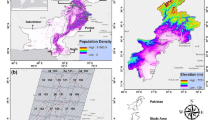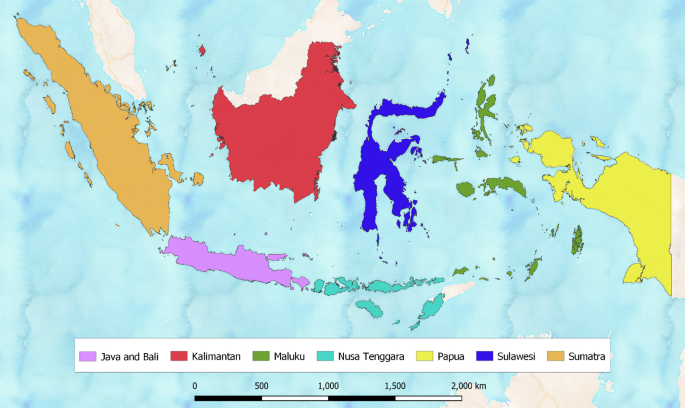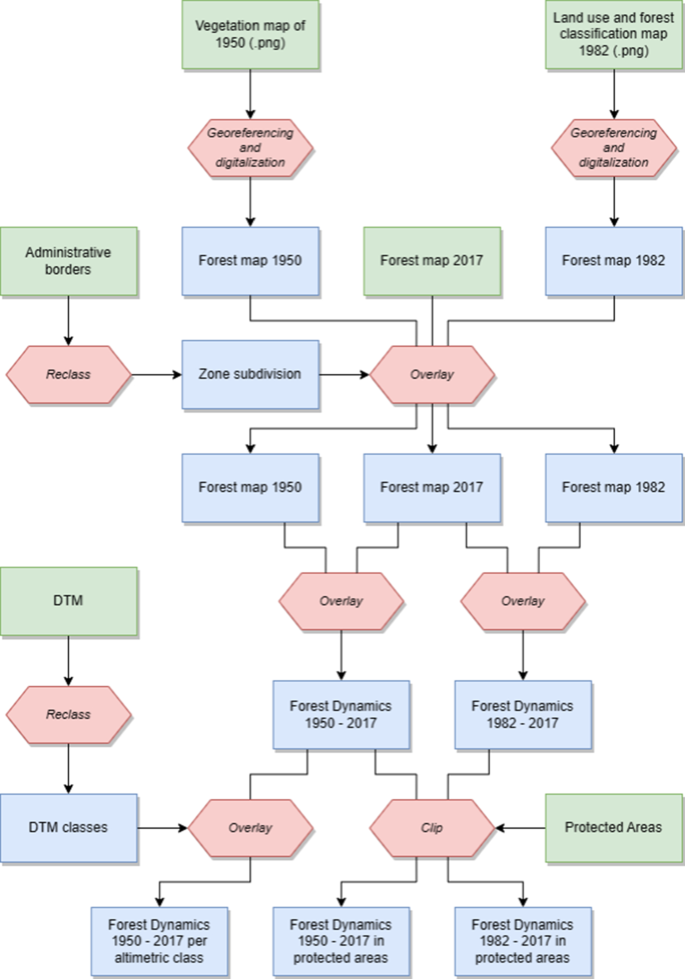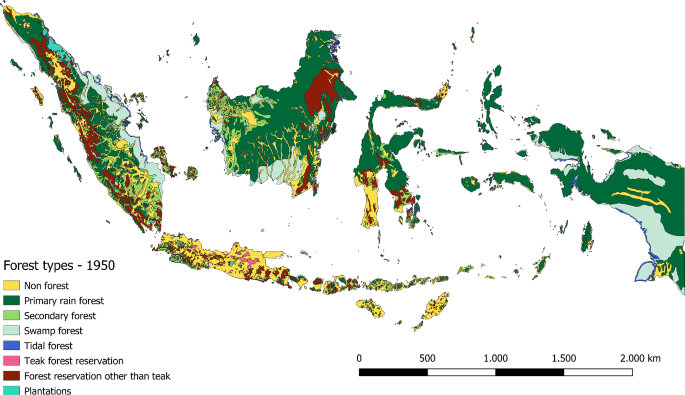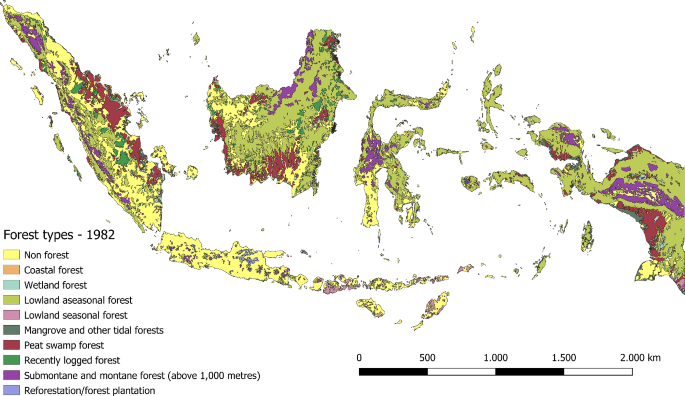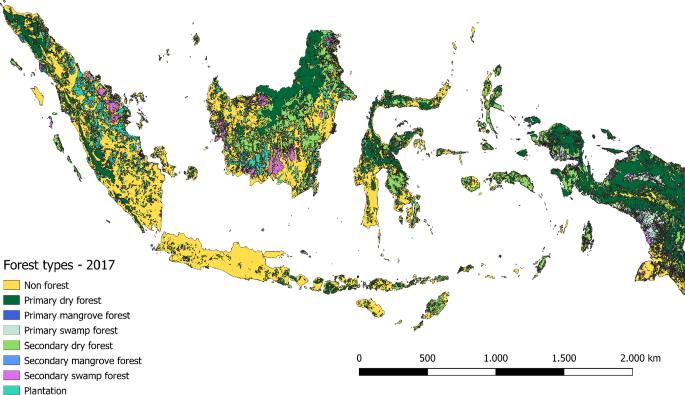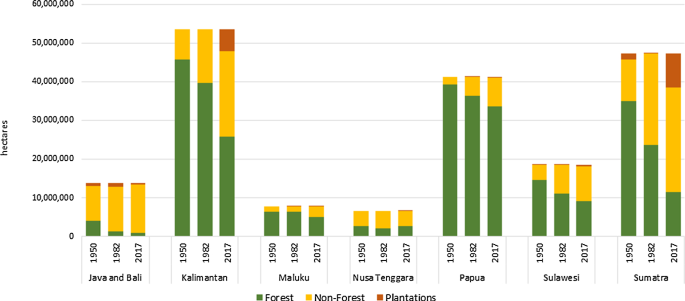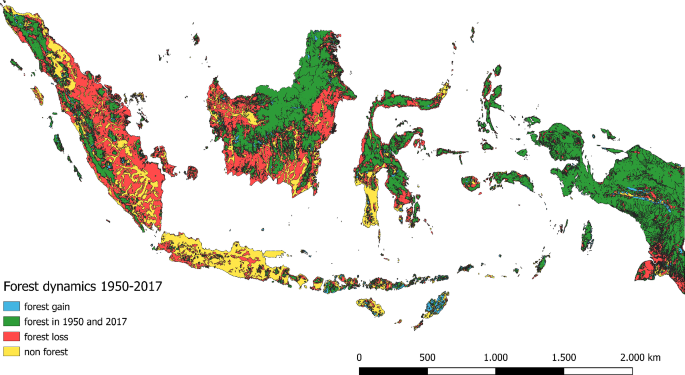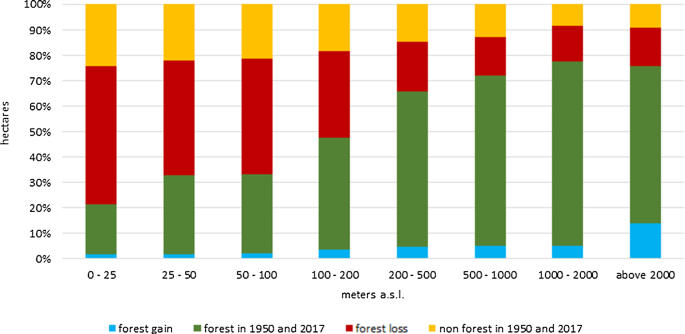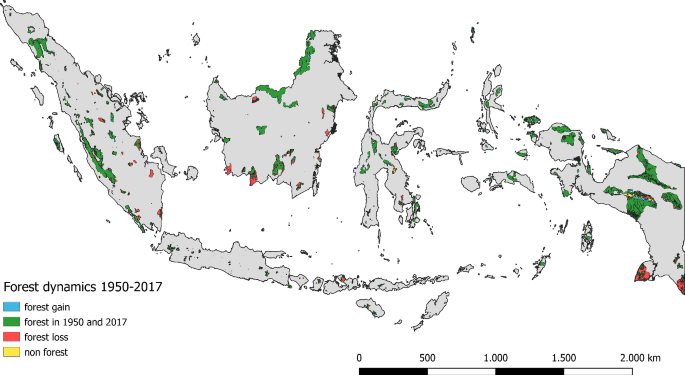Abstract
Indonesia is one of the countries with highest forest loss rates in the world. Protected areas (PAs) can have a key role in counteracting deforestation, especially if they are combined with the active involvement of local communities, rather than be only based on strict nature conservation. The study aims at assessing and measuring forest transformations in 1950–2017 through GIS-based spatial analyses, and to evaluate the role of PAs in preserving forests from deforestation. At national level forests dramatically decreased, passing from 78.3% of the total surface in 1950, to 63.8% in 1982 and to 46.8% in 2017. In the period 1950–2017, 35% of the national territory (over 66 million of hectares) has been affected by deforestation at an average rate of 985,200 ha/year; the areas where deforestation proceeded at higher rates are Sumatra (356,100 ha/year) and Kalimantan (303,360 ha/year). Deforestation occurred with higher intensity at lower altitudes and along the coast, due to the spread of modern plantations. The only exception is represented by Java and Bali as most of deforestation already occurred before 1950. PAs demonstrated to be effective in slowing down deforestation rates, but not in stopping it as deforestation is also affecting PAs. The study provided reliable spatial data on forest transformations in the last 67 years, highlighting differences related to geographical zone and altimetry, allowing the identification of the most vulnerable PAs. The amount of data produced at national and regional level could support further studies aimed at recognizing the best strategies to counteract deforestation, contributing to sustainable forests management and to forest preservation.
Similar content being viewed by others
Avoid common mistakes on your manuscript.
Introduction
Indonesia is one of the countries with the highest primary forest loss rate in the tropics (Turubanova et al. 2018; Margono et al. 2014) and deforestation is a topical issue at governmental and environmental level. Understanding the origins, causes, and effects of deforestation can help in properly address forest planning and policies at national and/or local level.
The most common cause of deforestation in Indonesia has always been related to the conversion of forests into agricultural land, a driver that is largely recognized to be the first cause of deforestation in most of the tropical countries (Pendrill et al. 2022). The cutting of forests to obtain new spaces for agriculture does not always occur in the same way and with the same techniques throughout the decades. In particular, there is the need to distinguish the spread of modern and intensive plantations on large surfaces from the small-scale traditional shifting agriculture. Indonesia has been particularly affected in the last decades by the spread of intensive palm plantations for palm oil production, that occurred with higher intensity in Kalimantan and Sumatra (Singh and Yan 2021; Carlson et al. 2013). Oil palm plantations are not the only cause of large-scale deforestation, as also fibre or timber plantations are considered relevant causes of deforestation in Indonesia (Austin et al. 2019; Petersen et al. 2016). Small scale and shifting agriculture have, and had, a different impact on deforestation in Indonesia and in other tropical countries, respect to intensive agriculture. Shifting agriculture in the past decades was usually reputed as a major threat to biodiversity and one of the main causes of deforestation in the tropics (Myers 1992; Lawrence et al. 2010). More recently, the impact of shifting agriculture on the environment has been reassessed, highlighting the reduced impact on soil erosion and water quality, the capability in preserving high levels of agrobiodiversity and traditional knowledge, and in some cases also contributing to counteract large-scale deforestation, especially if local indigenous communities are involved in forest planning and management (Brown and Schreckenberg 1998; Jinggut et al. 2012; Hernandez Marentes et al. 2022; Shimrah et al. 2015).
Another major cause of deforestation at national level is related to mining activities, especially considering that a significant part of Indonesian unprotected forests falls within mining concessions (Giljum et al. 2022; Abood et al. 2015). Finally, anthropic expansion, including new buildings or new infrastructures can also represent a threat to Indonesian forests at local level, but with a reduced impact concerning the overall surface compared to the aforementioned causes.
Despite the cause, tropical deforestation has serious effects on different environmental and social aspects, both in the short and long term. Tropical deforestation is considered a major source of greenhouse gases (GHG) (Houghton 2005), and according to Olsson et al. (2019) tropical deforestation and forest degradation emit several tons of CO2/year. Tropical deforestation can lead to increase in surface temperature and a decrease in evapotranspiration and precipitation (Shukla et al. 1990), without considering the indirect effects caused by the emissions of new human activities. Deforestation means the shrinking of habitats for fauna and flora species, and therefore a significant loss of biodiversity (Symes et al. 2018; Enuoh and Ogogo 2018; Vijay et al. 2016), also at soil level (Franco et al. 2019). Soil, one of the most important natural resources, is also directly threatened by deforestation, partly due to the increased risks of erosion that can occur right after forest cutting where there is no vegetation that can intercept heavy tropical rains, and partly due to the opening of new logging roads combined with the use of heavy tractors and trucks that compact the soil making it more difficult for the water to infiltrate and therefore favouring runoff and erosion (Moisa et al. 2022; Mohammad and Adam 2010; Karamage et al. 2016). In addition, deforestation is also directly related to forest fires; as reported by Adrianto et al. (2019) for Riau Province, Indonesia, the shrub vegetation developed after a cutting has a fire frequency more than 60 times compared to the one of primary forest.
Finally, it is important to highlight that tropical deforestation has direct and indirect effects on the wellbeing and health of local communities. Large-scale forest loss contributes to rising temperatures at local and regional level and to increasing the occurrence of extreme weather events, that are considered important drivers of emerging infectious diseases (Ellwanger et al. 2020; Thomson and Stanberry 2022). According to studies conducted in Indonesia among rural farmers, these climatic modifications also affect the work conditions, increasing the unsafe work time and the all-cause mortality, as well as declining the cognitive performance of rural workers (Wolff et al. 2021; Masuda et al. 2020). Deforestation can favour the spread of malaria (Garg 2019), a disease that tends to disproportionately infect women during their first pregnancy, causing greater harm to children born from these pregnancies (Chakrabarti 2021).The following table (Table 1) summarizes the main causes and the direct and indirect effects of deforestation at national level.
Protected areas (PAs) can have a key role in counteracting deforestation, even if they are not exempt from illegal logging or burning to obtain areas for pasture and/or agriculture (Wade et al. 2020). According to Brun et al. (2015), who conducted a study on Indonesian PAs comparing remote sensing data of 2000 and 2010, PAs exclusively managed for biodiversity conservation were ineffective in slowing down deforestation rates. The same risk is described by Curran et al. (2004), who reported that Kalimantan PAs are becoming increasingly isolated, since their surrounding areas are more and more degraded and deforested. However, deforestation rates inside Sumatran PAs in the period 1990–2000 have been proved to be lower than adjacent unprotected areas or in the wider landscape, therefore providing an important contribution in preserving local forests (Brun et al. 2015). Other authors (Gaveau et al. 2007) highlighted that Sumatra PAs failed to slow down overall forest loss rates caused by agricultural encroachment, but have been effective in reducing large-scale mechanised logging and in favouring forest regrowth. Deforestation within Sulawesi PAs seems mainly caused by illegal logging of most valued tree species, and by the growing demand of some agricultural products (i.e. coffee and cocoa) with consequent agricultural encroachments by small-farmers, rather than by intensive oil palm plantations (Supriatna et al. 2020). In this regard, it has been proved both for Indonesia and other tropical countries, that forms of protection based on the active involvement of local rural communities, who are authorized to conduct some traditional agro-silvo-pastoral practices, are much more effective in counteracting large-scale deforestation, than PAs based on strict nature conservation (Paiva et al. 2020; Hernandez Marentes et al. 2022; Santika et al. 2017).
Other initiatives at the international or governmental level have been promoted in the last few years with the aim of reducing deforestation rates. The most important one at the international level is probably the REDD+ (Reducing emissions from deforestation and forest degradation in developing countries), that started in 2005 under the United Nations Framework Convention on Climate Change (UNFCCC), with the aims of reducing GHGs and mitigating climate change through sustainable forest management and reducing deforestation. Various national agencies followed one another with regard to REDD+ issues, until 2020 with the establishment of the Environmental Fund Management Agency formed by the Ministry of Environment and Forestry (Suroso et al. 2020). In 2012 Indonesian REDD+ Task Force released the REDD+ National Strategies to spread the aims, vision and strategies related to forest management. In this document, the sustainable forest management and an integrated planning approach involving forestry, agroforestry, agriculture, and mining are promoted to reduce the impact of deforestation and GHGs emissions (Indonesian REDD+ Task Force 2012). The use of specific subsidies for regional governments that fulfil the objectives of forests and peatlands sustainable management can also be important to balance the reduction of local governments revenues (Tacconi and Muttaqin 2019). The REDD+ initiative demonstrated that involving local communities, i.e. in mangrove forests conservation through payments for ecosystem services scheme or in strengthening the rights of indigenous people living inside or adjacent to forests, is a key factor for obtaining effective results (Fay and Denduangrudee 2018). Unfortunately, the active involvement of local communities is not yet widespread in Indonesia and especially when forests are directly managed by the state, local rural communities are not enough considered in forest planning and management. Despite this, virtuous examples have been reported, and initiatives as community-based forest management or ecotourism, can be a key-factor for REDD+ success at site level (Sidik et al. 2018). Overall, even if important results have been achieved, the REDD+ initiative seems to have only partly meet the initial expectations, and Indonesian forests continue to be threatened by several factors (Moeliono et al. 2020).
Considering the above, it is clear that deforestation in Indonesia continues to have major impacts both on the environment and on the social context. Many studies have been carried out in the last decades focusing on different aspects of deforestation in Indonesia. Some of them focused on a reduced time interval or only on specific islands or provinces, others were instead based on statistical data at national level, but without any spatial information or mapping of deforestation. Therefore, the study presented in this paper can contribute to fill some of the knowledge gaps, providing useful data for the understanding of the historical origin and evolution of deforestation in Indonesia at spatial level, comparing the findings outside and inside protected areas. In particular, the aims of our study are to:
-
1.
Assess forest transformations occurred in the last 70 years at national and regional level, also according to the different altitude ranges.
-
2.
Compare resulting spatial data inside and outside protected areas to assess their role in preserving the forest heritage from deforestation.
-
3.
Identify the protected areas that actually have a higher degree of forest integrity.
Materials and methods
The study area
Indonesia is the world’s largest archipelagic state with over 17,000 islands, the 14th largest country by area (1,904,569 km2), and the 4th most populous country (over 275 million people). The climate of Indonesia is almost entirely constant, mainly thanks to the uniformly warm waters that surround the country. Temperature varies little from season to season, while the main variables are rainfall and altitude. According to the Köppen–Geiger climate classification (Kottek et al. 2006), most of the country is characterized by a Tropical rainforest climate (Af), followed by Tropical monsoon (Am) or Tropical savannah (Aw) climates. Few areas, corresponding to the ones located at higher altitudes, are instead characterized by oceanic climates and subtropical highland climates (Csb, Cwb, Cfb) between 1,500 and 3,500 m a.s.l., and by tundra (ET) or by Subpolar oceanic climate (Cfc) on the highest Papuan highlands and peaks above 3,500 m a.s.l.
The country is characterized by different types of forests, mainly depending on rainfall and altitude: mangrove forests along the coast, lowland tropical rainforests, and mountain forests in inland areas of Sumatra, Sulawesi, and Borneo. Peat swamp forests are instead found in the southern parts of Kalimantan and Sumatra, while the highest altitudes of Papua are occupied by subalpine and alpine vegetation (Tsujino et al. 2016). Soils too are very different one another, due to the morphological and climatic variability, and to the extension of the country.
Materials
Different sources have been used and compared to analyze the forest surface changes in the last 67 years.
Two different historical maps in raster format referring to the years 1950 and 1982 have been used as the basis for investigating the forest surfaces in the past. The oldest map with a sufficient level of detail about the vegetation types that is possible to find for all the country is the Vegetation Map of Indonesia published in 1950 and produced by the Planning Department of the Forest Service, under the supervision of L.W. Hannibal, with a scale 1:2,500,000; this map is available as a raster file on the website of the European Digital Archive of Soil Maps (EuDASM) (https://esdac.jrc.ec.europa.eu/Eudasm/DVD/asia/lists/cid.htm) (Selvaradjou et al. 2005). There are also some maps older than the 1950 one, but according to van Steenis (1958) they have to be considered inadequate or not precise both for the level of accuracy of the forest types’ identification and for the scale. Cornelis Gijsbert Gerrit Jan van Steenis was a Dutch botanist who substantially contributed to the knowledge of Southeast Asia vegetation. He also produced a Vegetation map of Malysia 1:5,000,000, published in 1958 for the UNESCO Humid Tropics Research Project. This map is really similar to the one of 1950, that according to van Steenis it is of a “greater precision” compared to the older ones; therefore, the 1950 Vegetation Map of Indonesia produced by the Planning Department of the Forest Service can be considered the more accurate and, at the same time, the older historical document mapping the different types of vegetation in Indonesia at national level.
The second map that has been used is the Land Use (Map 10) and 1982 Forest Classification, compiled in 1990 using different data sources, through a collaboration between Land Resources Department, Overseas Development Natural Resources Institute, United Kingdom and Bina Programme Directorate, Directorate General for Settlement Preparation, Department of Transmigration, Republic of Indonesia; this map has been downloaded in raster format from FAO online Map Catalogue.
Concerning the most recent spatial data of forest types in Indonesia, we used the forest types of 2017 provided by the Indonesian Kementerian Lingkungan Hidup dan Kehutanan (Ministry of Environment and Forestry) and downloaded as separate shapefiles from https://mapforenvironment.org/group/IndonesiaLandCover.
Regarding the forest type classification, each of the aforementioned maps have a different legend, that is based on different features (Table 2). I.e. the map of 1982 differentiate among the forest types on an altitudinal basis, while the 1950 map is based on general forest types. In addition, the 1950 Vegetation Map of Indonesia uses some symbols to characterize the forest type according to the main species, but since this data is not available for 1982 and 2017, it has been decided not to consider this additional level of detail. To avoid excessive simplification regarding the description of the forest types for each year, it has been decided not to carry out a reclassification of the legend; for the overlapping of the different years, instead, only the forest presence/absence has been considered, and “plantations” have been included among non-forest areas, as they mainly correspond to oil palm plantations and other tree plantations.
Regarding the presence of Protected Areas (PAs), the World Database on Protected Areas (WDPA) has been downloaded as shapefiles from ProtectedPlanet website for Indonesia, updated in November 2022 (UNEP-WCMC and IUCN 2022).
Country boundaries have been downloaded from GADM.org (Database of Global Administrative Areas) in November 2022. Islands less than 500 ha has been deleted from this shapefile, as no info about the forest type in historical maps was available for these territories. In addition, to present and analyze the results more clearly it has been decided to divide the national territory into 7 geographical zones, instead of presenting the results according to the 38 provinces (Fig. 1).
A Digital Terrain Model (DTM) with a resolution equal to about 230 m has been used for statistical elaborations of the results according to the altimetry. The DTM used is the Global Multi-resolution Terrain Elevation Data 2010 (GMTED2010), downloaded from EarthExplorer.usgs.gov and developed by the US Geological Survey (USGS) and the National Geospatial-Intelligence Agency (NGA). Each tile contains different geotiff files, including minimum elevation, maximum elevation, mean elevation, median elevation, and standard deviation of elevation. All the elaborations according to the altimetry have been performed using the mean elevation raster file.
Methodology
The applied methodology is depicted in Fig. 2.
The first step has been the georeferencing of the 1950 and 1982 maps into a GIS software; georeferencing has been manually made with the software QGIS 3.22.8. After this step, the two historical maps of 1950 and 1982 have been manually digitalized to obtain two vector files of the forest types. Not all the land uses have been digitalized, but only the ones related to forests and plantations, listed in Table 2.
All the following spatial analyses have been performed with QGIS 3.22.3 and GRASS GIS 7. The three different layers referring to the three years (1950, 1982, 2017) have then been overlapped with the geographical division of Indonesia. To evaluate forest changes, the 1950, 1982, and 2017 forest surface layers have been intersected, allowing to identify the unchanged surface, the forest gain and the forest loss. The resulting shapefiles have then been clipped with the boundaries of the PAs to evaluate the differences regarding forest surface changes inside and outside them; the original PAs database has previously been modified, deleting the 196 features (on a total of 688) that were classified as maritime protected areas, and, since the aim of this study focuses on the presence of any kind of nature protection, all the remaining features have been merged in order to avoid overlapping among different types of PAs with similar boundaries in the same place.
Concerning the elaborations of the results according to the altimetry, the original DTM has been reclassified into elevation classes. Instead of dividing the territory in homogeneous classes with the same altitude, it has been decided to apply variable classes to facilitate the analysis of the results; in fact, after some attempts, it has been decided that the following variable altitude classes are the most suitable for representing the complex morphology and altimetry of the territory. The class altitudes are the following: 0–25 m a.s.l., 25–50 m a.s.l., 50–100 m a.s.l., 100–200 m a.s.l., 200–500 m a.s.l., 500–1000 m a.s.l., 1000–2000 m a.s.l., above 2000 m a.s.l. After that, the classified raster file has been transformed into a vector layer to perform spatial analyses with the forest types and the forest changes layers.
Some limitations related to the materials used during this research have been identified. Data resulting from GIS elaborations of historical maps must be used and understood considering possible causes of inaccuracy (Stäuble et al. 2008). The first cause is related to the historical maps themselves and to the fact that these maps have been created in different years and by different people. This means that maps were produced using different methodologies, level of detail, classification, spatial accuracy, tools and scientific knowledge; even the basic definition of forest may vary between different years. The period of the year in which field survey were performed can also be important, especially for tidal and mangrove forests or for places with distinct dry and wet seasons. A second problem can be related to georeferencing historical maps, as the perfect overlay is almost impossible, even using a high number of control points. To partly avoid this last problem, the original maps, in some cases, have been divided in smaller parts and georeferenced separately to obtain a more accurate georeferencing. Finally, also the manual digitalization of historical maps can represent another cause of inaccuracy if not performed at a suitable scale. Despite these limitations the use of historical maps is already largely assessed in studies dealing with changes of landscape and environment, representing crucial databases to investigate and understand the main trends through the centuries and the decades (Vellend et al. 2013). For the current research all the manually performed GIS elaborations have been carried out with the highest possible level of accuracy and precision.
Results
Forests in 1950
In 1950, about 78.3% of the total national surface was covered by different types of forests. Most of the national territory was covered by primary rain forests (Table 3), that accounted for 45.3% of the national surface or 57.8% of the total forest surface. Swamp forests, that included mangrove areas, occupied 12.8% of the total surface, followed by forest reservation other than teak (9.9%) and by secondary forests (8.2%). Other forest surfaces were composed by teak forest reservations (0.5%) and tidal forests (1.6%), while plantations were at that time still limited to 1.2% of the national surface.
The distribution of the different forest types was not uniform within the country (Fig. 3). Primary rain forests were concentrated in Papua, Maluku islands, Sulawesi, Kalimantan and part of Sumatra, while they were really rare in Java and Bali. Secondary forests were mainly found in western Kalimantan, Nusa Tenggara and Sumatra, while swamp and tidal forests occupied smaller areas in the north-eastern part of Sumatra, and big portions of coastal Kalimantan and Papua. Areas classified as non-forest, corresponding to cultivations and grasslands, were mainly concentrated in Java and Bali (65.3%), in Nusa Tenggara (59.9%), and in the south-western part of Sulawesi. Plantations were mainly located in Sumatra, Java and Bali.
Forests in 1982
In 1982 about 63.8% of the total national surface was covered by different types of forests, most of them classified as lowland aseasonal forests (Table 4), that occupied 39.3% of the national surface, representing 61.7% of the total forest surface. According to the 1982 map, peat swamp forests were found on 9.6% of the national surface, followed by submontane and montane forests (7.7%) and by recently logged forests (2.5%). Other forest types were represented by mangrove and other tidal forests (2.4%) and by wetland forests (1.3%), while lowland aseasonal forests and coastal forests were limited to less than 1.1% of the total surface.
Lowland aseasonal forests were mainly located in Maluku (where they cover 70.1% of the surface), Papua (54.2%), Kalimantan (50.7%) and Sulawesi (44.2%) (Fig. 4). Peat swamp forests were also common, particularly in Papua (12.4%), Sumatra (13.6%) and Kalimantan (11.3%), while submontane and montane forests (above 1000 m a.s.l.) were mainly found in Papua (13.3%), Sulawesi (11.9%) and Sumatra (6.9%). Mangrove and other tidal forests were instead common along the coasts of Papua (where they cover 4.7% of the surface) and Maluku (3%). Areas classified as non-forest were mainly concentrated in Java and Bali (83%), in Nusa Tenggara (68.4%), and in the south-western part of Sulawesi and south Sumatra. Plantations were almost all concentrated in Java.
Forests in 2017
In 2017, the area with the highest percentage of forest cover was Papua (82%), followed by Maluku (64.3%) (Table 5). The most widespread forest types at national level corresponded to primary dry forests (20.8%) and to secondary dry forests (18.9%), both mainly located in Papua, where they represented, respectively, 47.1% and 16.4% of the total surface. Primary dry forests were also found in Kalimantan (17.7% of the surface) and Sulawesi (21% of the surface), while secondary dry forests were common in Maluku (50.6% of the surface), Sulawesi (27.1% of the surface), and Kalimantan (23.7% of the surface) (Fig. 5). Primary and secondary swamp forest accounted respectively for 2.7 and 3.1% of the national surface and were mainly located in Papua, where primary swamp forests occupied 4,876,615 ha, corresponding to 11.8% of the surface. Other forests were composed by primary and secondary mangrove forests, whose total surface was limited to 1.5% of the national territory. Plantations were also common, with a total surface corresponding to 8.2% of the national territory, especially in Sumatra (where they account for 18.7% of the total surface) and Kalimantan (10.5% of the total surface). Non forest areas in 2017 were found on 44.9% of the national inland territory, primarily corresponding to cultivations and grasslands, and were mainly located in Java and Bali where they reached 90.7% of the surface, in Nusa Tenggara (58.7%), in the southern part of Sulawesi and Sumatra, and in the southern, eastern, and western parts of Kalimantan.
Forest changes in the period 1950–2017 inside and outside protected areas
The intersect of the layers of 1950 and 2017 allowed to obtain spatial data about the changes that involved forests in the last 67 years, while the overlay with PAs boundaries provide data about the role of protected areas, allowing to compare the forest changes inside and outside PAs.
Data at national level highlight that 35% of the national territory (over 66 million of hectares) has been affected by deforestation in the last 67 years, at an average rate of around 985,200 ha/year. In addition, considering the two different time intervals (1950–1982, 1982–2017), deforestation rates are really similar, highlighting no big differences at national level between “old” and “recent” deforestation.
Significant discrepancies can instead be found between the different geographical zones (Fig. 6). In Sumatra deforestation occurred on 52.8% of the territory at an average rate of 372,300 ha/year, followed by Kalimantan (40%, 319,400 ha/year) and Sulawesi (33%, 91,500 ha/year). Papua is the zone that still preserves the highest percentage of “original forest”, as 78.9% of its territory was classified as forest both in 1950 and in 2017, but even if the percentage of the total surface affected by deforestation is the lowest among the different geographical zones, it anyhow corresponds to 16.3% of the total surface, equal to 6.7 million of hectares, with an average rate of 100,450 ha/year (Figs. 6 and 7). The situation is quite different in Java and Bali, as in 1950 most of the surface was already devoted to agriculture, but the study demonstrated that deforestation continued even in the last 67 years also in this part of the country; in fact, only 4.8% of the surface was classified as forest both in 1950 and in 2017. The only part of the country where the comparison highlighted an overall increase in the forest surface is Nusa Tenggara, since 22.2% of its territory falls under the classification “forest gain”; despite this data can partly be explained with the use of different historical sources produced with different methodologies, it is necessary to consider that 21% of the surface of this area is anyhow affected by deforestation.
Considering the altimetry, results highlight a clear trend at national level, with most of deforestation concentrated at lower altitudes and greater conservation of forest resources at higher altitudes, especially above 500 m a.s.l. In particular, only 19.5% of the national surface below 25 m a.s.l. preserves the forest surface of 1950, while 54.3% has been affected by deforestation. Going up in altitude, this percentage decrease to 45.1% in the range 25–50 m a.s.l., to 45.5% in the range 50–100 m a.s.l., to 34.1 in the range 100–200 m a.s.l., and to 19.6% in the range 200–500 m a.s.l. Above 500 m a.s.l. the percentage of the territory affected by deforestation is comprised between 14.1% and 15.4%, while the percentage of territory that is classified as forest both in 1950 and 2017 is between 61.7 and 72.6%. Moreover, it is interesting to notice that the in the altitude range 500–2000 m a.s.l. around 5% of the surface is occupied by new forest surfaces, while in the class above 2000 m a.s.l. this percentage rise up to 14.1%. The only area that do not follows this trend is the one of Java and Bali (and partly of Nusa Tenggara too), as deforestation is mainly located in the range 200–1000 m as.l., due to the fact that in 1950 the areas at lower altitudes were already deforested and turned into agricultural surface to support a particularly significant population growth (Fig. 8).
According to the November 2022 update of the World Database on Protected Areas (WDPA), Indonesian terrestrial PAs occupy a total surface of 21,665,522 ha, corresponding to 11.5% of the national terrestrial surface (Fig. 9). The percentage of total protected territory affected by deforestation in the period 1950–2017 is equal to 18.8% (with an average rate of 60,684 ha/year), that is a significantly lower value respect to the ones measured for the areas outside PAs (37.1%, average rate equal to 924,544 ha/year). However, this data does not seem to respect the evident differences at local level regarding the percentage of territory affected by deforestation inside and outside PAs. In most cases, the percentage of territory affected by deforestation is significantly lower inside PAs compared to what happened outside PAs, especially in Sumatra (21.5% in PAs and 56.5% outside PAs), Sulawesi (14.1% in PAs and 35% outside PAs), Maluku (8.3% in PAs and 27.8% outside PAs) and Kalimantan (22.1% in PAs and 41.8% outside PAs) (Table 6). In Papua and Nusa Tenggara these percentages are instead similar, while in Java and Bali the percentage of territory affected by deforestation inside PAs is higher than the one measured outside PAs (25.4% inside PAs and 24.4% outside PAs), probably due to the fact that the territory outside PAs was largely classified as non-forests already in 1950.
Comparing deforestation rates in PAs of the two different periods (1950–2017), it is interesting to notice that for all the geographical zones, this rate is always higher in the last 35 years, with an average value at national level equal to 84,216 ha/year.
Results of the forest changes assessment in the period 1982–2017 also allowed to identify the PAs with a high level of forest integrity (all the PAs has been established after 1980), as well as those where deforestation occurred with high intensity (Fig. 9). Considering only the National Parks, the ones presenting lower deforestation rates in the last 35 years are the following: Kayan Mentarang NP, Betung Kerihun NP, Bukit Baka - Bukit Raya NP (Kalimantan); Bogani Nani Wartabone NP, Lore Lindu NP, Ganda Dewata NP (Sulawesi); Aketajawe Lolobata NP, Manusela NP (Maluku); Alas Purwo NP (Java); Kelimutu NP (Nusa Tenggara); Kerinci Seblat NP, Bukit Tiga Puluh NP, Bukit Dua Belas NP, Siberut NP (Sumatra). On the contrary, the National Parks with highest deforestation rates in the period 1982–2017, are: Danau Sentarum NP, Sebangau NP, Tanjung Puting NP, Kutai NP (Kalimantan); Rawa Aopa Watumohai NP (Sulawesi); Gunung Merapi NP, Gunung Merbabu NP, Gunung Halimun - Salak NP (Java); Gunung Rinjani NP (Nusa Tenggara); Tesso Nilo NP, Berbak NP, Gunung Maras NP, Way Kambas NP (Sumatra). It is also interesting to notice that deforestation in various National Parks follows a regular pattern, clearly starting from the borders.
Discussion
The present research provided reliable spatial data regarding forest surface transformations in Indonesia in the last 67 years, demonstrating that deforestation is still the main threat for Indonesian forests. Indonesia, as other Southeast Asian countries is experiencing fast land cover changes, therefore, it is crucial to monitor these changes at various scale through spatial analysis for more accurate environmental planning and conservation (Miettinen et al. 2016).
According to Mackinnon (1997) almost all the total terrestrial area was originally forested, and local population started to cut the forest to enlarge the cultivable area in different periods in the different parts of the country. According to the present study, in 1950 forests occupied 78.3% of the total terrestrial surface, a percentage close to the one reported by Tsujino et al. (2016) for the same year (83.5% of total land area), considering that in our case plantations have not been included among forests. Since in 1982 the total forest cover has been found to be equal to 63.8%, it is evident that large scale deforestation started immediately after WWII in most of the country and not in the last three decades, but with significant differences among different areas. Until the ‘50s most of the lowland rainforests were still managed through manually selective cutting practices that probably had reduced impact on forest regeneration (Kartawinata et al. 2001), even if this management form can modify the species composition in the long term.
An exception is represented by Java and Bali, as this study demonstrated that already in 1950 forest occupied only 29.2% of their total surface. Around 1930, population density in Java was already high (313 person/km2) compared to the other big Indonesian islands, where it was less than 25 person/km2, and, therefore, there was the need to increase rice production to feed the population, cutting large areas of primary forests (Nawiyanto 2015; Darmayanti 2023). In fact, according to Boomgaard (1999), deforestation of mountain slopes in Java started to be perceived as a problem already around 1850, leading to the establishment of a colonial Forest Service and to the creation of protected forests. Java, at that time, represented an isolated but significant case due to its population density, while large-scale deforestation has a more recent origin in the rest of the country (Smiet 1990). Despite most of the surface was already devoted to agriculture, after 1950 deforestation in Java continued with high intensity, representing one of the main environmental problems at local level, especially due to the consequences on erosion, landslides and soil loss (Haryadi and Andarwati 2019). Forests in Java are largely fragmented and lower-altitude forests already disappeared decades ago as demonstrated by our study, but according to Higginbottom et al. (2019) deforestation within Javan protected areas greatly decreased in the last 20 years, almost ceasing after 2007.
It is also necessary to consider that, in the past, deforestation, as in most tropical and subtropical countries, was related to the demand of local population for agricultural land, firewood, charcoal, timbers and housing materials (Dagnachew et al. 2020), while in the last two decades a big portion of deforestation has been caused by the spread of industrial oil palm plantations, and partly also by mining activities. In addition, in the period 2014 and 2016 small-scale farming was responsible of more than one-quarter of all deforestation, a trend common to all Southeast Asia, where deforestation caused by smallholder agriculture is accelerating due to the rapid population growth (Seymour and Harris 2019).
At national level, as part of the REDD+ initiative, Indonesia launched a forest moratorium in 2011 to suspend the granting of new concession for logging, oil palm and wood fibre concessions within designated areas with the aim of reducing deforestation and CO2 emissions. The moratorium, initially planned for two years, was renovated until it became permanent in 2019. The percentage of the total national terrestrial surface affected by the moratorium was initially around 34–35%, and mainly focused on conservation and protection of peatlands and primary forests, as designated by the Indonesian Ministry of Environment and Forestry (Murdiyarso et al. 2011). Even if the moratorium increased the pressure on forests excluded from this type of initiative, good results have been achieved, that could be further improved considering the recent ban on new licenses for oil palm plantations imposed by the Indonesian government for a period of three years (Leijten et al. 2021). In the period 2001–2016 oil palm plantations had been responsible of 23% of total large-scale deforestation in Indonesia (Austin et al. 2019), but with significant differences from one region to another (Meijaard et al. 2020), as demonstrated by this study, without considering that industrial oil palm plantations rarely bring direct benefits to rural communities, especially to the ones living near or adjacent primary forests (Santika et al. 2019). Since 2017, the combination of the moratorium, of the decrease in oil palm price and of the increased awareness among consumers, caused a slowing down of deforestation associated to industrial plantations (Gaveau et al. 2019, 2022). Despite this positive trend, oil palm price has doubled since the start of the COVID-19 pandemic and its demand is expected to increase (Shigetomi et al. 2020; Leijten et al. 2021).
According to the findings of our study, the areas where deforestation is proceeding at higher rates are Sumatra island (356,100 ha/year) and Kalimantan (303,360 ha/year) as also confirmed by Nikonovas et al. (2020), who reported that the Sumatra and Kalimantan islands, home to the majority of Indonesia’s carbon-rich peatlands, have been particularly affected by loss and degradation of primary forests. A large part of deforestation has been due to the spread of plantations, occurring at an average rate of 197,079 ha/year (+ 563%).
Despite these particularly high rates of deforestation, our study demonstrated that deforestation rates are significantly lower within PAs, especially in some parts of the country (Sumatra, Sulawesi, Maluku, Kalimantan), as the percentage of surface affected by deforestation within PAs is often the half comparted to the percentage outside PAs. This is also confirmed by other studies; in 1990–2000 deforestation rates inside Sumatran PAs have found to be lower compared to adjacent unprotected areas or to the wider landscape, even if deforestation and logging have not ceased within Sumatran PAs (Gaveau et al. 2009). Previous studies also reported that protection measures partly contributed to reducing large-scale mechanized logging and to stabilize agricultural encroachments enabling forest re-growth in Sumatra (Gaveau et al. 2007). Reducing forest fragmentation at the landscape level is also crucial to (re)connect different habitats and to preserve ecological corridors for local fauna (Poor et al. 2019).
Conclusions
The first group of Indonesian National Parks was established in 1980, just before the intermediate reference year that has been considered in this study, and at least 20–25 years after the beginning of large-scale deforestation in most of the country. Our research confirmed the important role of PAs in slowing down deforestation rates compared to the situation outside PAs, especially in some parts of the country where plantations, mainly of oil palms, have spread extensively in the last three decades. Results also proved that PAs are not exempt from deforestation, even in the last 30 years, especially due to the deforestation starting from the margins eroding the forests located along the border with the area outside PAs. Therefore, along with the strengthening of PAs, there is a need to apply an effective sustainable forest management also to the forests not included in the PAs system and to those located along their borders. The recent trend of promoting at national level both social forestry and community-based forest management, seems to have positive effects in improving community well-being, promoting sustainable forest management, and reducing overexploitation of natural resources (Erbaugh 2019; Putraditama et al. 2019). In addition, particular attention should be paid to the areas at lower altitudes, where deforestation occurs with higher intensity, especially along the coasts, where mangrove and other tidal forests have a key role also in protecting coastlines from erosion, as well as representing unique ecosystems.
The applied methodology, despite the limitations already highlighted due to comparing different sources produced with different procedures, allowed to provide reliable spatial data on forest surface transformations in Indonesia in the last 67 years and regarding the role of Protected Areas. The big amount of produced data at regional level have led to the identification of the most vulnerable areas and of the ones that are still rich in forest integrity and associated biodiversity. Further studies at local level or focusing on specific PAs, could help in linking different forest management strategies with deforestation, contributing to the identification of possible solutions that can be replicated for a sustainable management of national forest resources and for their preservation towards future generations. This research can be considered as a starting point for such studies, and, at the same time, can help in the identification of those management approaches that have been most successful in protecting forest areas, those that most contributed to forest loss mitigation.
References
Abood SA, Lee JSH, Burivalova Z, Garcia-Ulloa J, Koh LP (2015) Relative contributions of the logging, fiber, oil palm, and mining industries to forest loss in Indonesia. Conserv Lett 8(1):58–67. https://doi.org/10.1111/conl.12103
Adrianto HA, Spracklen DV, Arnold SR, Sitanggang IS, Syaufina L (2019) Forest and land fires are mainly associated with deforestation in Riau province, Indonesia. Remote Sens 12(1):3. https://doi.org/10.3390/RS12010003
Austin KG, Schwantes A, Gu Y, Kasibhatla PS (2019) What causes deforestation in Indonesia? Environ Res Lett 14(2):024007. https://doi.org/10.1088/1748-9326/aaf6db
Boomgaard P (1999) Oriental nature, its friends and its enemies: conservation of nature in late-colonial Indonesia, 1889–1949. Environ Hist 5(3):257–292. https://doi.org/10.3197/096734099779568245
Brown D, Schreckenberg K (1998) Shifting cultivators as agents of deforestation: assessing the evidence. Overseas Development Institute, London
Brun C, Cook AR, Lee JSH, Wich SA, Koh LP, Carrasco LR (2015) Analysis of deforestation and protected area effectiveness in Indonesia: a comparison of bayesian spatial models. Glob Environ Change 31:285–295. https://doi.org/10.1016/j.gloenvcha.2015.02.004
Carlson KM, Curran LM, Asner GP, Pittman AM, Trigg SN, Marion Adeney J (2013) Carbon emissions from forest conversion by kalimantan oil palm plantations. Nat Clim Change 3(3):283–287. https://doi.org/10.1038/nclimate1702
Chakrabarti A (2021) Deforestation and infant mortality: evidence from Indonesia. Econ Hum Biol 40:100943. https://doi.org/10.1016/j.ehb.2020.100943
Curran LM, Trigg SN, McDonald AK, Astiani D, Hardiono YM, Siregar P, Kasischke E (2004) Lowland forest loss in protected areas of Indonesian Borneo. Science 303(5660):1000–1003. https://doi.org/10.1126/science.1091714
Dagnachew M, Kebede A, Moges A, Abebe A (2020) Land use land cover changes and its drivers in Gojeb river catchment, Omo Gibe basin, Ethiopia. J Agric Environ Int Dev (JAEID) 114(1):33–56. https://doi.org/10.12895/jaeid.20201.842
Darmayanti AF (2023) The impact of deforestation on community lives in Mojowarno, Jombang 1854–1930. Embracing new perspectives in history, social sciences, and education. Routledge, London, UK, pp 69–73
Ellwanger JH, Kulmann-Leal B, Kaminski VL, Valverde-Villegas JM, Veiga ABG, Spilki FR, Chies JAB (2020) Beyond diversity loss and climate change: impacts of amazon deforestation on infectious diseases and public health. Anais da Academia Brasileira de Ciências. https://doi.org/10.1590/0001-3765202020191375
Enuoh OO, Ogogo AU (2018) Assessing tropical deforestation and biodiversity loss in the cross river rainforest of Nigeria. Open J For 8(3):393–408. https://doi.org/10.4236/ojf.2018.83025
Erbaugh JT (2019) Responsibilization and social forestry in Indonesia. For Policy Econ 109:102019. https://doi.org/10.1016/j.forpol.2019.102019
Fay C, Denduangrudee HMS (2018) An uneven path toward rights and REDD+ in Indonesia. background paper. Center for Global Development, Washington DC
Franco AL, Sobral BW, Silva AL, Wall DH (2019) Amazonian deforestation and soil biodiversity. Conserv Biol 33(3):590–600. https://doi.org/10.1111/cobi.13234
Garg T (2019) Ecosystems and human health: the local benefits of forest cover in Indonesia. J Environ Econ Manag 98:102271. https://doi.org/10.1016/j.jeem.2019.102271
Gaveau DL, Wandono H, Setiabudi F (2007) Three decades of deforestation in southwest Sumatra: have protected areas halted forest loss and logging, and promoted re-growth? Biol Conserv 134(4):495–504. https://doi.org/10.1016/j.biocon.2006.08.035
Gaveau DL, Epting J, Lyne O, Linkie M, Kumara I, Kanninen M, Leader-Williams N (2009) Evaluating whether protected areas reduce tropical deforestation in Sumatra. J Biogeogr 36(11):2165–2175. https://doi.org/10.1111/j.1365-2699.2009.02147.x
Gaveau DL, Locatelli B, Salim MA, Yaen H, Pacheco P, Sheil D (2019) Rise and fall of forest loss and industrial plantations in Borneo (2000–2017). Conserv Lett 12(3):e12622. https://doi.org/10.1111/conl.12622
Gaveau DL, Locatelli B, Salim MA, Manurung T, Descals A, Angelsen A, Sheil D (2022) Slowing deforestation in Indonesia follows declining oil palm expansion and lower oil prices. PLoS ONE 17(3):e0266178. https://doi.org/10.1371/journal.pone.0266178
Giljum S, Maus V, Kuschnig N, Luckeneder S, Tost M, Sonter LJ, Bebbington AJ (2022) A pantropical assessment of deforestation caused by industrial mining. Proc Natl Acad Sci. https://doi.org/10.1073/pnas.211827311
Haryadi FT, Andarwati S (2019) The roles of religion in participatory development communication in the environmental issues in Indonesia. J Agric Environ Int Dev (JAEID) 113(2):171–180. https://doi.org/10.12895/jaeid.20192.887
Hernandez Marentes MA, Venturi M, Scaramuzzi S, Focacci M, Santoro A (2022) Traditional forest-related knowledge and agrobiodiversity preservation: the case of the chagras in the indigenous reserve of Monochoa (Colombia). Biodivers Conserv 31(10):2243–2258. https://doi.org/10.1007/s10531-021-02263-y
Higginbottom TP, Collar NJ, Symeonakis E, Marsden SJ (2019) Deforestation dynamics in an endemic-rich mountain system: conservation successes and challenges in west Java 1990–2015. Biol Conserv 229:152–159. https://doi.org/10.1016/j.biocon.2018.11.017
Houghton RA (2005) Tropical deforestation as a source of greenhouse gas emissions. Trop deforestation Clim change, 13
Indonesian REDD+ task force, (2012) REDD+ national strategy. Indonesia REDD+ task force, Jakarta, Indonesia
Jinggut T, Yule CM, Boyero L (2012) Stream ecosystem integrity is impaired by logging and shifting agriculture in a global megadiversity center (Sarawak, Borneo). Sci Total Environ 437:83–90. https://doi.org/10.1016/j.scitotenv.2012.07.062
Karamage F, Shao H, Chen X, Ndayisaba F, Nahayo L, Kayiranga A, Zhang C (2016) Deforestation effects on soil erosion in the Lake Kivu Basin, DR Congo-Rwanda. Forests 7(11):281. https://doi.org/10.3390/f7110281
Kartawinata K, Riswan S, Gintings AN, Puspitojati T (2001) An overview of post-extraction secondary forests in Indonesia. J Trop For Sci 13:621–638
Kottek M, Grieser J, Beck C, Rudolf B, Rubel F (2006) World map of the Köppen-Geiger climate classification updated. Meteorol Z 15:259–263. https://doi.org/10.1127/0941-2948/2006/0130
Lawrence D, Radel C, Tully K, Schmook B, Schneider L (2010) Untangling a decline in tropical forest resilience: constraints on the sustainability of shifting cultivation across the globe. Biotropica 42(1):21–30. https://doi.org/10.1111/j.1744-7429.2009.00599.x
Leijten F, Sim S, King H, Verburg PH (2021) Local deforestation spillovers induced by forest moratoria: evidence from Indonesia. Land Use Policy 109:105690. https://doi.org/10.1016/j.landusepol.2021.105690
Mackinnon J (1997) Protected areas systems review of the Indo-Malayan realm. Asian Bureau for Conservation, Canterbury
Margono BA, Potapov PV, Turubanova S, Stolle F, Hansen MC (2014) Primary forest cover loss in Indonesia over 2000–2012. Nat Clim Change 4(8):730–735. https://doi.org/10.1038/nclimate2277
Masuda YJ, Garg T, Anggraeni I, Wolff NH, Ebi K, Game ET, …, Spector JT (2020) Heat exposure from tropical deforestation decreases cognitive performance of rural workers: an experimental study. Environ Res Lett 15(12):124015. https://doi.org/10.1088/1748-9326/abb96c
Meijaard E, Brooks TM, Carlson KM, Slade EM, Garcia-Ulloa J, Gaveau DL, Sheil D (2020) The environmental impacts of palm oil in context. Nat plants 6(12):1418–1426. https://doi.org/10.1038/s41477-020-00813-w
Miettinen J, Shi C, Liew SC (2016) 2015 land cover map of southeast Asia in 250 m spatial resolution. Remote Sens Lett 7:701–710. https://doi.org/10.1080/2150704X.2016.1182659
Moeliono M, Brockhaus M, Gallemore C, Dwisatrio B, Maharani CD, Muharrom E, Pham TT (2020) REDD+ in Indonesia: a new mode of governance or just another project? For Policy Econ 121:102316. https://doi.org/10.1016/j.forpol.2020.102316
Mohammad AG, Adam MA (2010) The impact of vegetative cover type on runoff and soil erosion under different land uses. CATENA 81(2):97–103. https://doi.org/10.1016/j.catena.2010.01.008
Moisa MB, Dejene IN, Hirko O, Gemeda DO (2022) Impact of deforestation on soil erosion in the highland areas of western Ethiopia using geospatial techniques: a case study of the upper anger watershed. Asia Pac J Reg Sci. https://doi.org/10.1007/s41685-022-00238-7
Murdiyarso D, Dewi S, Lawrence D, Seymour F (2011) Indonesia’s forest moratorium: a stepping stone to better forest governance? CIFOR, Bogor
Myers N (1992) Tropical forests: the policy challenge. Environmentalist 12(1):15–27. https://doi.org/10.1007/BF01267592
Nawiyanto N (2015) Forest resources exploitation and its impact in the extreme salient of java, 1870–1970. Tawarikh, 6(2)
Nikonovas T, Spessa A, Doerr SH, Clay GD, Mezbahuddin S (2020) Near-complete loss of fire-resistant primary tropical forest cover in Sumatra and Kalimantan. Commun Earth Environ 1(1):65. https://doi.org/10.1038/s43247-020-00069-4
Olsson L, Barbosa H, Bhadwal S, Cowie A, Delusca K, Flores-Renteria D, Stringer L (2019) Land degradation: IPCC special report on climate change, desertification, land 5 degradation, sustainable land management, food security, and 6 greenhouse gas fluxes in terrestrial ecosystems. IPCC Special report on climate change, Desertification, Land 5 degradation, sustainable land management, Food security, and 6 Greenhouse gas fluxes in terrestrial ecosystems. Intergovernmental panel on climate change (IPCC), Geneva, p 1
Paiva PFPR, de Lourdes Pinheiro Ruivo M, da Silva Júnior OM, de Nazaré Martins Maciel M, Braga TGM, de Andrade MMN, Ferreira BM (2020) Deforestation in protect areas in the amazon: a threat to biodiversity. Biodivers Conserv 29(1):19–38. https://doi.org/10.1007/s10531-019-01867-9
Pendrill F, Gardner TA, Meyfroidt P, Persson UM, Adams J, Azevedo T, West C (2022) Disentangling the numbers behind agriculture-driven tropical deforestation. Science. https://doi.org/10.1126/science.abm9267
Petersen R, Goldman ED, Harris N, Sargent S, Aksenov D, Manisha A, Kurakina I (2016) Mapping tree plantations with multispectral imagery: preliminary results for seven tropical countries. World Resources Institute, Washington DC, p 525
Poor EE, Frimpong E, Imron MA, Kelly MJ (2019) Protected area effectiveness in a sea of palm oil: a Sumatran case study. Biol Conserv 234:123–130. https://doi.org/10.1016/j.biocon.2019.03.018
Putraditama A, Kim YS, Meador AJS (2019) Community forest management and forest cover change in Lampung, Indonesia. For Policy Econ 106:101976. https://doi.org/10.1016/j.forpol.2019.101976
Santika T, Meijaard E, Budiharta S, Law EA, Kusworo A, Hutabarat JA, Wilson KA (2017) Community forest management in Indonesia: avoided deforestation in the context of anthropogenic and climate complexities. Glob Environ Change 46:60–71. https://doi.org/10.1016/j.gloenvcha.2017.08.002
Santika T, Wilson KA, Budiharta S, Law EA, Poh TM, Ancrenaz M, Meijaard E (2019) Does oil palm agriculture help alleviate poverty? a multidimensional counterfactual assessment of oil palm development in Indonesia. World Dev 120:105–117. https://doi.org/10.1016/j.worlddev.2019.04.012
Selvaradjou S-K, Montanarella L, Spaargaren O, Dent D (2005) European digital archive of soil maps (EuDASM)-soil maps of asia. Office of the Official Publications of the European Communities, Luxembourg
Seymour F, Harris NL (2019) Reducing tropical deforestation. Science 365(6455):756–757. https://doi.org/10.1126/science.aax8546
Shigetomi Y, Ishimura Y, Yamamoto Y (2020) Trends in global dependency on the indonesian palm oil and resultant environmental impacts. Sci Rep 10(1):1–11. https://doi.org/10.1038/s41598-020-77458-4
Shimrah T, Rao KS, Saxena KG (2015) The shifting agricultural system (Jhum) and strategies for sustainable agroecosystems in northeast India. Agroecol Sustain Food Syst 39(10):1154–1171. https://doi.org/10.1080/21683565.2015.1089350
Shukla J, Nobre C, Sellers P (1990) Amazon deforestation and climate change. Science 247(4948):1322–1325. https://doi.org/10.1126/science.247.4948.1322
Sidik F, Supriyanto B, Krisnawati H, Muttaqin MZ (2018) Mangrove conservation for climate change mitigation in Indonesia. Wiley Interdiscip Rev Clim Change 9(5):e529. https://doi.org/10.1002/wcc.529
Singh M, Yan S (2021) Spatial–temporal variations in deforestation hotspots in Sumatra and Kalimantan from 2001–2018. Ecol Evol 11(12):7302–7314. https://doi.org/10.1002/ece3.7562
Smiet AC (1990) Forest ecology on java: conversion and usage in a historical perspective. J Trop For Sci 2:286–302
Stäuble S, Martin S, Reynard E (2008) Historical mapping for landscape reconstruction. Examples from the Canton of Valais (Switzerland). In Mountain mapping and visualisation: 6th ICA mountain cartography workshop, 11–15 feb. 2008, Lenk (pp. 211–217)
Supriatna J, Shekelle M, Fuad HA, Winarni NL, Dwiyahreni AA, Farid M, Zakaria Z (2020) Deforestation on the indonesian island of Sulawesi and the loss of primate habitat. Global Ecol Conserv 24:e01205. https://doi.org/10.1016/j.gecco.2020.e01205
Suroso DS, Setiawan B, Pradono SP, Fitriyanto MS (2020) Cross-country study of Indonesia green sukuk and REDD. Bandung Institute of Technology, Indonesia
Symes WS, Edwards DP, Miettinen J, Rheindt FE, Carrasco LR (2018) Combined impacts of deforestation and wildlife trade on tropical biodiversity are severely underestimated. Nat Commun 9(1):1–9. https://doi.org/10.1038/s41467-018-06579-2
Tacconi L, Muttaqin MZ (2019) Reducing emissions from land use change in Indonesia: an overview. For Policy Econ 108:101979. https://doi.org/10.1016/j.forpol.2019.101979
Thomson MC, Stanberry LR (2022) Climate change and vectorborne diseases. N Engl J Med 387(21):1969–1978. https://doi.org/10.1056/NEJMra2200092
Tsujino R, Yumoto T, Kitamura S, Djamaluddin I, Darnaedi D (2016) History of forest loss and degradation in Indonesia. Land Use Policy 57:335–347. https://doi.org/10.1016/j.landusepol.2016.05.034
Turubanova S, Potapov PV, Tyukavina A, Hansen MC (2018) Ongoing primary forest loss in Brazil, Democratic Republic of the Congo, and Indonesia. Environ Res Lett 13(7):074028. https://doi.org/10.1088/1748-9326/aacd1c
UNEP-WCMC and IUCN (2022) Protected planet: The world database on protected areas (WDPA) and world database on other effective area-based conservation measures (WD-OECM). UNEP-WCMC and IUCN, Cambridge. Available at: www.protectedplanet.net
van Steenis CGG (1958) Concise outline of Malaysian vegetation mapping and literature. In Humid tropics research—study of tropical vegetation. Proc. of the kandy Symposium. UNESCO (pp. 68–73)
Vellend M, Brown CD, Kharouba HM, McCune JL, Myer-Smith IH (2013) Historical ecology: using unconventional data sources to test for effects of global environmental change. Am J Bot 100(7):1294–1305. https://doi.org/10.3732/ajb.1200503
Vijay V, Pimm SL, Jenkins CN, Smith SJ (2016) The impacts of oil palm on recent deforestation and biodiversity loss. PLoS ONE 11(7):e0159668. https://doi.org/10.1371/journal.pone.0159668
Wade CM, Austin KG, Cajka J, Lapidus D, Everett KH, Galperin D, Sobel A (2020) What is threatening forests in protected areas? a global assessment of deforestation in protected areas, 2001–2018. Forests 11(5):539. https://doi.org/10.3390/f11050539
Wolff NH, Zeppetello LRV, Parsons LA, Aggraeni I, Battisti DS, Ebi KL, Spector JT (2021) The effect of deforestation and climate change on all-cause mortality and unsafe work conditions due to heat exposure in Berau, Indonesia: a modelling study. Lancet Planet Health 5(12):e882–e892. https://doi.org/10.1016/S2542-5196(21)00279-5
Acknowledgements
Authors want to thank Dr. Jukka Miettinen and Dr. Soo Chin Liew for having shared their 2015 land cover map of Southeast Asia in 250 m spatial resolution.
Funding
Open access funding provided by Università degli Studi di Firenze within the CRUI-CARE Agreement. The authors have not disclosed any funding.
Author information
Authors and Affiliations
Contributions
Conceptualization AS and FP; methodology AS, FP and QY; software QY and FP; writing AS, FP and QY; supervision AS.
Corresponding author
Ethics declarations
Competing interest
The authors declare no competing interests.
Additional information
Communicated by Mauro Agnoletti.
Publisher’s Note
Springer Nature remains neutral with regard to jurisdictional claims in published maps and institutional affiliations.
Rights and permissions
Open Access This article is licensed under a Creative Commons Attribution 4.0 International License, which permits use, sharing, adaptation, distribution and reproduction in any medium or format, as long as you give appropriate credit to the original author(s) and the source, provide a link to the Creative Commons licence, and indicate if changes were made. The images or other third party material in this article are included in the article's Creative Commons licence, unless indicated otherwise in a credit line to the material. If material is not included in the article's Creative Commons licence and your intended use is not permitted by statutory regulation or exceeds the permitted use, you will need to obtain permission directly from the copyright holder. To view a copy of this licence, visit http://creativecommons.org/licenses/by/4.0/.
About this article
Cite this article
Santoro, A., Piras, F. & Yu, Q. Spatial analysis of deforestation in Indonesia in the period 1950–2017 and the role of protected areas. Biodivers Conserv (2023). https://doi.org/10.1007/s10531-023-02679-8
Received:
Revised:
Accepted:
Published:
DOI: https://doi.org/10.1007/s10531-023-02679-8


